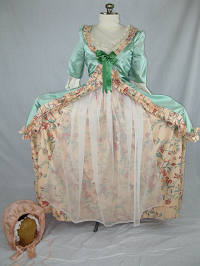1770s
The last quarter of the 18th century produced an amazing variety of fashions. One of these was the polonaise. This term refers to an overdress that was cut like the man’s coat of the same period. It is tied across the bodice with bows resembling a ladder. This is a copy of a court gown worn by Madame Pompidou. Although the colonists wanted to be separate from Europe, they were quick to mimic their fashions.
The front and underarm of the bodice is cut in one piece with no side seams. The bodice is closed only at the top of the center front, and falls back in slight folds showing the stay or corset and the petticoat. The center back and two far back seams end in inverted pleats which are accented with black cording, tassles and buttons. There are two loops of fine braid attached to the inside for looping up the skirt. The edge of the polonaise is trimmed with 21 yards of ruched chintz. A bosom knot hides cleavage. The tippet is used to conceal the deep neckline. Necklace was just that - a piece of lace tied around the neck.
This green polonaise was popular in the 1770s. The lady’s social status is immediately apparent. The cost of material for a petticoat and gown with matching box pleated trim would be great. One diary of a lady of the court talks about having the milliner redecorate the same gown for six years. This silk brocade would be an investment of a lifetime. The apron as well as her lace gloves tells everyone who sees her, she need do no work except needle work. Indispensables such as a fan and looking glass are kept in her long purse. The gown has a train which can be drawn up by use of strings. Hooks and eyes close the front of the gown. The colonists imported all the fancy materials. George Washington imported many fancy gloves for Martha and her daughter.
A scarf is used to conceal a deep neckline. The corset, which serves as the bodice of the gown, is of rose brocade and heavily boned. The long point in front kept the figure straight below the waist. Hair styles of the 1770s were very elaborate and time-consuming with stiff curls piled high, plastered and sometimes powdered. They were left intact for several weeks. The result of this was a sanctuary for parasites. To relieve the itching caused by these insects, a fork-like implement was invented. The doremeuse cap with lappets is shirred lace and has a black bow. To protect the extreme hairdo from the elements, ladies wore a bonnet called a calash. If folded flat, like the carriage hood that is was named after for ease in storage. Lace gloves were also a status symbol to cover the hands.
In 1776 there was no clear-cut definition of what was outerwear and what was underwear. At this period, the undergarment was merely the part of the costume worn under the outer garment. For the foundation of this costume, the chemise could also serve as night wear. It has a drawstring at the neck with a lace ruffle. This allows it to be adjusted to fit the neckline of any gown. The sleeves are finished with lace ruffles. Around the waist are a set of pockets and a ribbon girdle, which is not as constraining as the girdles of the 1940s. From the girdle hangs a chatelaine, which had been worn for many years previous to this era as jewelry with a purpose. On this one we see a key, a pomander containing cotton scented with French perfume, and a snuff bottle. Ladies would place a little snuff in the hollow between the thumb and first finger then sniff a little up each nostril, which would be followed by a sneeze and a sneeze. Pockets were worn singly or in pairs. These were tied around the waist and contained many necessities.
Click photo for detailed views.


